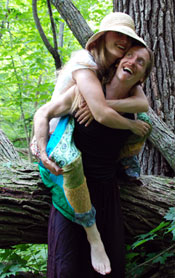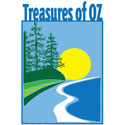It’s starting to look a lot like spring here in Wisconsin, with temperatures reaching 40 degrees F during the day. For Rebecca and I, that means it’s time to take the shoes off!
Some people think it’s weird that we enjoy going barefoot, but for us there is nothing quite like the feel of leaves or grass or stone (or yes, at this time of the year, even snow!) underfoot. Unconstrained by shoes, your toes can wiggle gloriously, and you get to feel the tendons and muscles of your feet moving and flexing after they’ve been stuck immobile in shoes and boots all winter long.
Some experts are beginning to suggest that shoes aren’t all they’re cracked up to be. In the book Born to Run, by Christopher McDougall, the author cites numerous studies that show that wearing high-tech running shoes, for instance, actually increases our risk of injury. It turns out that our feet are marvelously designed, and that most foot problems might actually be caused by our shoes, which effectively act like casts on our feet, restricting movement (think muscle atrophy and reduced flexibility), cutting us off from the ground, and creating a moist, dark, hot environment perfect for growing fungus and other interesting organisms. In other words, we think our feet are tender, weak, and ill-designed, but most of us have never given them a chance to build muscle and flexibility. What might happen if we set them free?
Perhaps shoes aren’t actually evil, but Rebecca and I are often happier without. If you begin early in the spring, walking on the pavement where the snow has melted, the bottoms of your feet will become conditioned, and by summer you’ll amaze everybody by being able to run over gravel and go for unshod walks through the woods. After some spring conditioning, I’m able to rock-climb, backpack, and enjoy long-distance runs, all without shoes.
If you’ve never given barefoot a try, we’d encourage you to give it a chance this summer — perhaps on some lush grass — and see what it’s like to experience your toes moving through the green. If you want to try going full-on extreme super ultra barefoot, then now’s the time to kick off those shoes and start walking sans shoes wherever the snow has melted!
The First-Time Barefooter’s Guide to Getting Started
It’s simple. Just take off your shoes. Start around the house, to get some initial conditioning on your soles, and to begin to strengthen the muscles and tendons. Feet that have been cloistered in shoes for a long time have to remember what it’s like to flex, stretch, and wiggle. You’ll be building up strength through your ankles, as well as throughout your foot.
When it’s warm out, try going outside. Soft grass is the best place to begin your outdoor adventures. It’s a marvelous feeling to immerse your toes in grass, and your chances of getting a puncture wound are minimal. If you enjoy this, you can try a little more. Purchase some flip-flops or open sandals, which will let your feet breathe (if you have issues with fungus they’ll soon disappear once you get your feet breathing again). Plus, flip-flops are easy to slip off if you see a path or stretch of grass that beckons.
The Extreme Barefooter’s Guide to Going Shoeless
Purchase yourself some flip-flops or sandals, and unless it’s absolutely necessary, never put on socks or shoes again. (Here in Wisconsin, temps drop so low that at some point you have little choice but to boot up.) I begin conditioning in early spring, walking down our paved country road. I’ll walk on the road itself, venture over to the shoulder, and walk through patches of ice and snow. Sometimes I even sort of scuff my feet or wiggle them in sand. This is all to condition the soles, which will develop soft callouses and will become less sensitive to things.
Then comes the fire. Do this at your own risk, obviously, but I’ve found that if I warm the bottoms of my feet over the campfire (as I would my hands), and then give them small doses of hotter temps, my feet seem to quicken on their way to getting barefoot-ready.
Next comes jogging. I find that my gait is naturally different (no heel strikes) when I run barefoot, and by doing short distances I begin to build foot strength and flexibility. After that it’s a process of gradually adding more running distance and more extreme terrain. A month after training begins, I can go almost anywhere that I’d wear shoes (except into nice restaurants and such, which seem to frown on the practice =)
For the Rest of Us
One last option is to try some of the new ‘minimalist footwear’. Perhaps the wackiest, funnest, and most well-designed are Vibram Five-Fingers, which are ‘shoes’ that have toes. These still have the disadvantage of keeping your feet in a hot, moist environment, and they don’t allow your soles to condition (they also reduce sensation), but at least they allow your feet to stretch, wiggle, and interact with their environment. Of course, people will look at you very strangely when you wear them, since they are quite unlike any other footwear around.
If you do give bare feet a try, enjoy! Your feet will probably thank you =)
Posted on March 4th, 2010 by Kenton Whitman
Filed under: Getting Outdoors | 12 Comments »


 Even children can go out and easily identify delicious natural treats. Wood sorrel is a great example with its tangy flavour, and during a recent ‘survival’ class that we taught for third graders, the children tasted ‘Golden Birch’ (yellow birch), and were delighted with the minty taste of the buds.
Even children can go out and easily identify delicious natural treats. Wood sorrel is a great example with its tangy flavour, and during a recent ‘survival’ class that we taught for third graders, the children tasted ‘Golden Birch’ (yellow birch), and were delighted with the minty taste of the buds.

